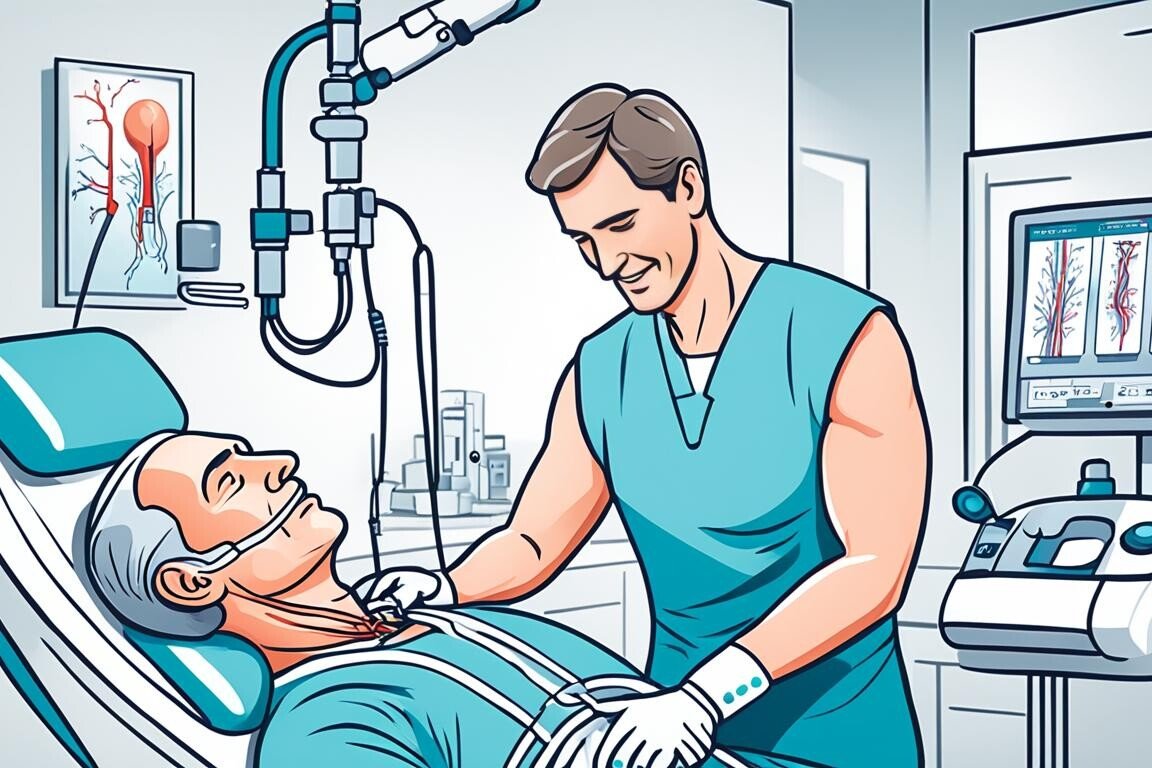Back pain is a common issue in India, affecting many people. There are effective home remedies to help manage it. This article will cover the best ways to handle back pain relief at home. We’ll look at causes, symptoms, lower back pain exercises, proper posture, home remedies for back pain, natural back pain treatment, stretches for back pain, back pain management, back pain relief products, chronic back pain relief, and upper back pain relief.
If you’re facing occasional or chronic back pain, learning about home remedies for back pain can help. By understanding causes, doing lower back pain exercises and stretches for back pain, and trying natural back pain treatment, you can manage your back pain relief at home better. This can improve your overall well-being.
Table of Contents
ToggleUnderstanding Back Pain Causes and Symptoms
Back pain can stem from many sources, like muscle strains, spinal problems, or chronic conditions like arthritis. Knowing the common causes and types of back pain is key to finding the right treatment.
Common Causes of Back Pain
Some top causes of back pain are:
- Muscle or ligament strain from overuse or improper lifting
- Herniated or bulging discs in the spine
- Spinal stenosis, or the narrowing of the spinal canal
- Osteoarthritis, rheumatoid arthritis, or other forms of arthritis
- Osteoporosis, leading to compression fractures in the spine
- Myofascial pain syndrome, which involves muscle pain and stiffness
Types of Back Pain
Back pain can show up in different ways, such as:
- Sharp, stabbing pain
- Dull, aching discomfort
- Radiating pain that travels down the legs (sciatica)
- Stiffness and limited range of motion
- Muscle spasms or tightness
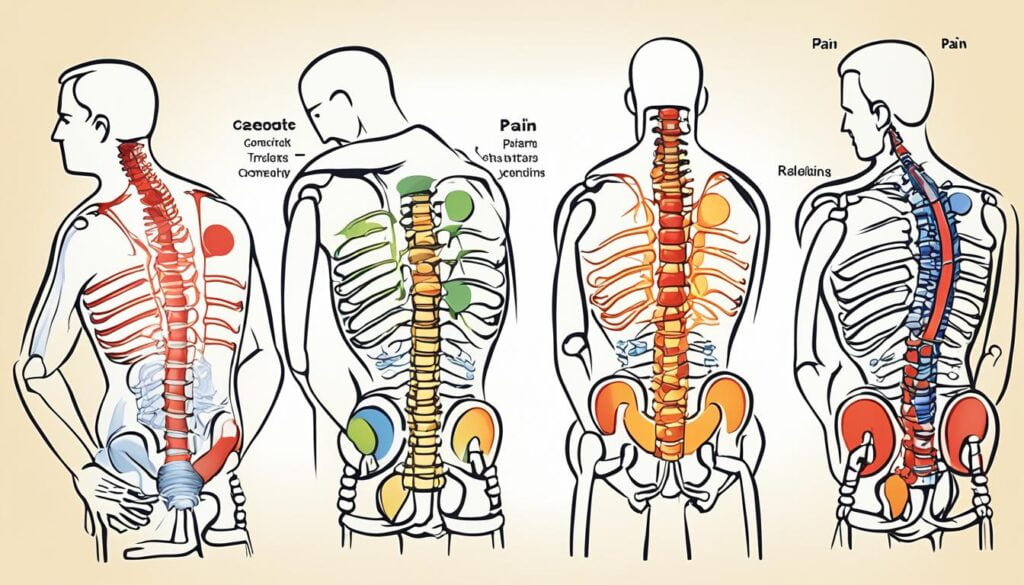
The pain can be in the lower, middle, or upper back. Knowing where and how your back hurts can help pick the right treatment.
Back pain is common, but seeing a doctor is a good idea if it’s severe, lasts a long time, or has other concerning signs. A healthcare professional can figure out the cause and create a treatment plan just for you.
Exercise and Stretching for Back Pain Relief
Exercise and stretching are great for managing back pain. Activities like walking, swimming, and yoga strengthen the core and improve flexibility. They do this without putting too much stress on your back.
Low-Impact Exercises for Back Pain
- Walking: This simple exercise can help improve blood flow and reduce back pain.
- Swimming: The buoyancy of water takes pressure off your back, making it a great low-impact option.
- Yoga: Gentle yoga poses can help stretch and strengthen the muscles that support your back.
Stretches to Alleviate Back Pain
- Touching your toes: This simple stretch can help lengthen the hamstrings and relieve lower back tension.
- Cobra pose: This backbend can help open up the front of the spine and improve flexibility.
- Cat-cow pose: This gentle movement can help mobilize the spine and reduce stiffness.
- Child’s pose: This restorative pose can help release tension in the lower back and hips.
Start slowly and listen to your body. Gradually increase the number of repetitions as the exercises become easier. If you have ongoing back pain or a recent injury, consider consulting a physical therapist or healthcare professional.

Proper Posture and Ergonomics
Keeping the right posture is key to avoiding and managing back pain. Bad posture, whether sitting, standing, or walking, can make back pain worse. Having a well-set workstation helps by placing the computer screen at eye level and using a supportive chair.
About 80% of people will have back pain at some point, often from bad posture. Studies also show that good posture cuts the risk of musculoskeletal issues by up to 80%. Bad posture is linked to 85% of back, neck, and shoulder discomfort, tension, and long-term health problems.
To better your posture and set up an ergonomic workspace, follow these tips:
- Adjust your desk and chair so your computer screen is at eye level, easing neck and back strain.
- Use a chair that supports your lower back and lets your feet rest flat on the floor.
- Stretch and move regularly to avoid the back pain that comes with sitting too long.
- Think about using a standing desk or an adjustable one to switch between sitting and standing during the day.
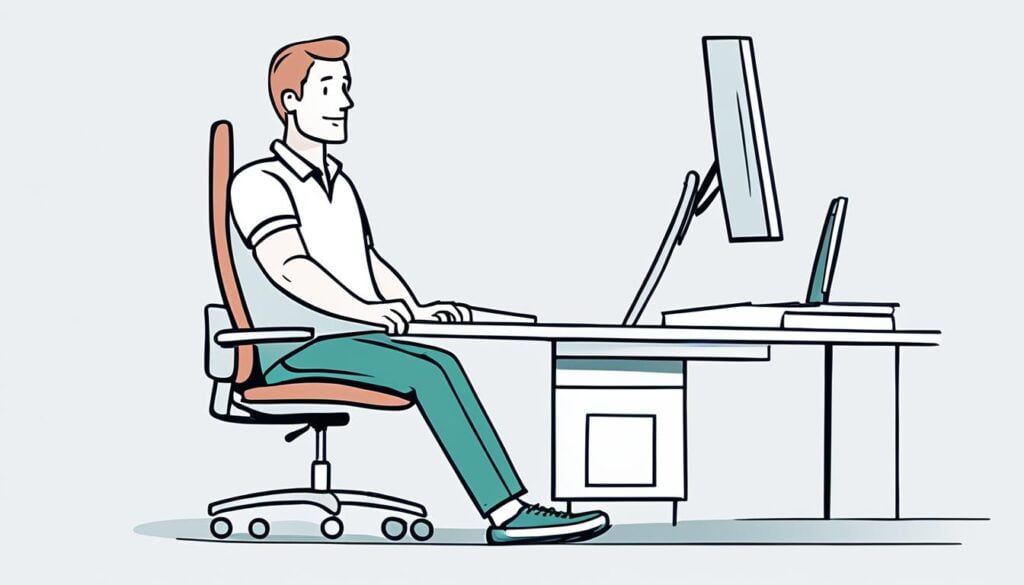
By focusing on proper posture and ergonomics, you can lessen back pain and boost your comfort and health.
Hot and Cold Therapy for Back Pain
Using hot and cold therapy can help manage back pain at home. Ice packs and heat therapy can target the root causes of pain. They offer relief by reducing inflammation and easing discomfort.
Using Ice Packs for Back Pain
Ice packs can lessen inflammation and numb back pain. They do this by making blood vessels smaller and slowing down nerve signals. This cooling effect helps ease sharp back pain. To use ice packs well, put them on the sore spot for 15-20 minutes a few times a day.
Applying Heat Packs for Relief
Heat therapy, on the other hand, boosts blood flow and relaxes muscles. It gives quick relief. Use heat packs, warm baths, or heating pads to ease stiffness and calm muscle spasms. Keep the heat warm but not too hot, and use it for 15-30 minutes at a stretch.
Switching between hot and cold therapy can work best for back pain. Using ice and heat together can help relieve pain and aid healing.
Always use these therapies safely and as directed. Don’t use extreme temperatures on your skin, and stop if you feel any discomfort or skin issues. If your back pain doesn’t get better or gets worse, see a healthcare professional for help.
Pain Relief Creams and Ointments
Over-the-counter pain relief creams and ointments can help with back pain at home. Menthol-based creams have a cooling effect that dulls pain. CBD creams can also help with pain and inflammation. These treatments work well with other therapies for better back pain management.
Menthol-Based Creams for Cooling Effect
Menthol-based creams like Tiger Balm and Dr. Blue Cool Gel have an organic compound. This compound makes the area cool, numbing the pain. About one in five Americans use these creams for back pain relief.
CBD Creams for Back Pain Relief
CBD creams are becoming more popular for pain and inflammation relief. Research on CBD for back pain is ongoing but shows promising results. Over 16 million adults in the U.S. have chronic back pain. Many are trying CBD creams as a natural pain relief option.
When using pain relief creams or ointments, always follow the instructions. If the pain doesn’t get better or gets worse, talk to a healthcare professional.
Massage Therapy for Back Pain Management
If you’re dealing with back pain, massage therapy could help. It can offer short-term relief for some people. But, its long-term effects are still being studied.
Massage uses techniques like kneading and friction to relax muscles and improve blood flow. This can make pain and discomfort less for a while. But, the evidence for using massage on chronic lower back pain is not strong.
Even without strong long-term evidence, many doctors see massage as a safe, natural way to handle back pain. When combined with other treatments like exercise and pain meds, massage can help a lot with healing and relief.
How well massage works for back pain can differ from one person to another. The massage type, the therapist’s skill, and the back pain cause all affect the results. If you’re thinking about trying massage, find a licensed therapist who can customize the treatment for you.
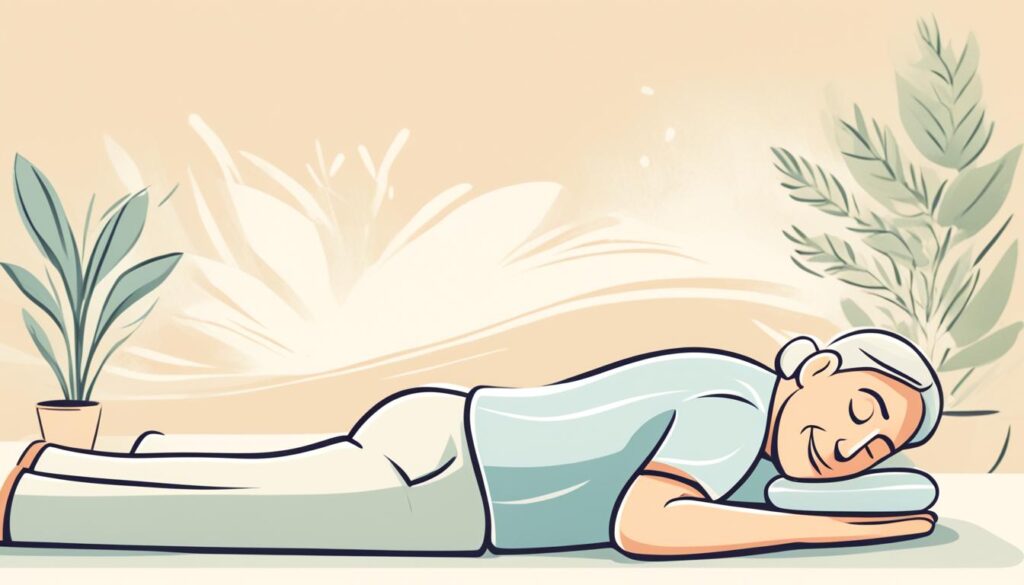
There are also other massage types that might help with back pain, like trigger point massage and sports massage. These focus on specific muscles and spots to ease pain and tension.
While massage can be a useful tool for back pain, it should be part of a complete treatment plan. Work with your doctor to create a plan that addresses the root of your back pain for the best outcomes.
Herbal and Natural Remedies for Back Pain
If you’re looking for natural ways to ease back pain, consider herbal and homeopathic remedies. Arnica is a plant-based option that has been used for centuries. It helps with muscle aches, pain, and swelling.
Arnica for Muscle Pain and Swelling
Arnica is a top choice for back pain because it’s thought to reduce inflammation and ease pain. Though not all studies support its benefits, many people find it helpful. They use arnica creams or gels on sore or swollen back muscles.
To use arnica, apply a small amount to the sore area and massage it in. Always follow the product’s instructions and don’t use it on broken skin. Some might also take arnica supplements, but check with a healthcare professional first.
Other natural remedies like ginger, turmeric, and essential oils might also help with back pain. But remember, they shouldn’t replace medical care for serious or ongoing back pain.

If your back pain is severe or doesn’t go away, see a healthcare provider. They can find out what’s causing it and help you with a full treatment plan. With the right mix of natural remedies, lifestyle changes, and professional care, you can feel better and improve your health.
Footwear and Orthotics for Back Pain Relief
The shoes you wear can greatly affect your back pain. Shoes with good arch support and low heels can ease back strain. Sometimes, custom orthotics are needed to help your feet align right, which can lessen back pain.
Studies show that the right footwear and orthotics are key to easing back pain. More people are looking to buy products that help with back pain, focusing on shoes and orthotics. Online shopping trends highlight what buyers want, like a good shopping experience and tracking data for back pain products.
Experts suggest heels should be under 2 inches to keep your spine aligned. Shoes for running with lots of cushioning and a rocker bottom are good for those with back issues. Sandals with arch support are better than flip-flops or shoes with a negative heel, which can make back pain worse.
If back pain doesn’t get better or gets worse, see a podiatrist or pedorthist. They can pick the right shoes and orthotics for you, giving your feet and back the support they need.
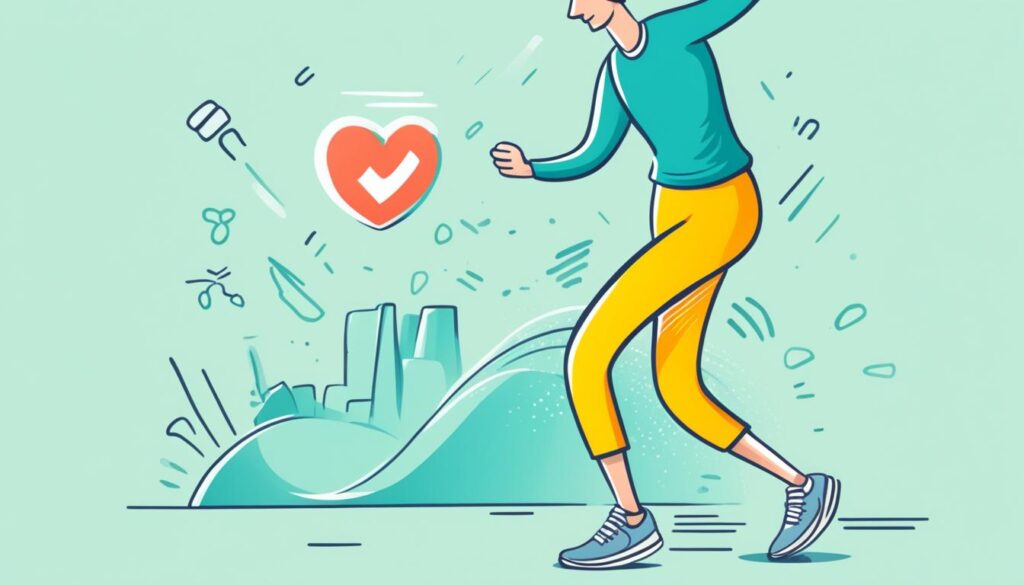
Choosing the right footwear and orthotics can really help with back pain and boost your health. Take your time to find the best fit and support for your feet. This could be the relief you’ve been looking for.
Improving Sleep Quality for Back Pain
Getting quality sleep is key when you have back pain. Some sleeping positions can help keep your spine aligned. This reduces strain on your back. [https://www.webmd.com/back-pain/sleep-tips-for-back-pain]Sleeping on your side with a pillow between your knees or on your back with a pillow under your knees can ease back pain.
Improving your sleep quality can also help manage back pain. In fact, research shows that chronic lower back pain often leads to sleep issues. People with chronic lower back pain are 58% more likely to have sleep problems than those who sleep well.
Sleeping Positions for Back Pain Relief
- Lie on your side with a pillow between your knees to keep your spine aligned.
- Sleep on your back with a pillow under your knees to support the natural curve of your spine.
- Avoid sleeping on your stomach, as this can put additional strain on your back.
Having a supportive, medium-firm mattress can also help with back pain. A 2021 study found that a new medium-firm mattress can cut back pain symptoms in half.
By adopting these sleep-friendly habits, you can better your sleep quality and ease your back pain. If your symptoms don’t get better or get worse, see a healthcare professional for help. They can give you a proper check-up and a treatment plan tailored to you.
Diet and Nutrition for Back Pain Management
The foods you eat can greatly affect your back pain and inflammation. Eating anti-inflammatory foods can help manage back pain. But, eating too many processed foods, added sugars, and unhealthy fats can make back pain worse.
Anti-inflammatory Foods for Back Pain
Eating a diet rich in plants and omega-3 fatty acids from coldwater fish like salmon, mackerel, sardines can reduce inflammation and ease back pain. Herbs and spices like basil, cinnamon, ginger, garlic, and turmeric are also great for fighting inflammation. Foods such as avocados, nuts, lean proteins, beans, and cocoa can also help reduce back pain.
Foods to Avoid for Back Pain Relief
It’s also key to avoid foods that can increase inflammation and make back pain worse. This includes processed foods, fast foods, saturated fats, white bread, sugary snacks, and fried foods. Cutting these out can help reduce your back pain.
Keeping a balanced, nutrient-rich diet is crucial for managing back pain. Eating anti-inflammatory foods and avoiding inflammatory ones can greatly improve your health and life quality.
Stress Management and Relaxation Techniques
Dealing with back pain can be tough on both your body and mind. Adding stress management and relaxation to your daily life can help a lot. These methods help you handle stress and tension, which can make your back pain worse.
Mindfulness and Meditation for Back Pain
Mindfulness meditation and other meditative practices are great for back pain. They help you stay in the moment and listen to your body. Regular meditation can slow down your heart rate, lower blood pressure, and improve digestion. All of this can help ease the strain on your back.
Breathing Exercises and Progressive Muscle Relaxation
Deep breathing and progressive muscle relaxation are also good for back pain. Deep breathing can quickly lower stress levels. Progressive muscle relaxation involves tensing and relaxing muscles to release tension. These methods can help control blood sugar, reduce stress hormones, and increase blood flow to muscles, offering overall relief.
Try different relaxation techniques to see what works for you. With regular practice, you can better manage stress and feel more calm and balanced. This can help you recover from back pain.
When to Seek Medical Attention for Back Pain
Many back pain cases can be handled at home. But, some times, you need to see a doctor. This is true if your back pain is severe, doesn’t go away, or gets worse. If you have symptoms like new or worse bowel/bladder issues, weakness in your limbs, or trouble walking, you should get help.
About one in five Americans has had back pain in the past month. Most low back pain goes away in four to six weeks, with or without treatment. Knowing when you need a doctor’s help is key.
- Severe, persistent, or worsening back pain
- New or worsening bowel/bladder issues
- Weakness in the limbs
- Gait and balance problems
These “red flag” symptoms suggest you might have a serious health issue. Seeing a doctor quickly is important. They can check for serious problems and decide on the best treatment. This could be medicines, physical therapy, or surgery.
If you’re unsure about when to see a doctor for back pain or when to seek medical attention for back pain, don’t wait. Getting help early can lead to better health and stop things from getting worse.
back pain relief at home
There are many home remedies and strategies for back pain relief. You can try using ice or heat, or do gentle stretches and exercises. These simple methods can help ease your pain and boost your back health.
Home Remedies for Immediate Relief
For quick relief from back pain, try these home remedies:
- Apply ice packs or cold compresses to the affected area to reduce inflammation and numb pain.
- Use topical pain relief creams or ointments containing ingredients like menthol or CBD to provide a cooling or soothing effect.
- Perform gentle stretches and exercises, such as those recommended by physical therapists, to increase mobility and blood flow.
Long-term Home Strategies for Back Pain Management
To manage back pain over time, try these strategies:
- Engage in regular low-impact exercises like walking, swimming, or yoga to strengthen the core and back muscles.
- Practice good posture and maintain proper ergonomics, especially when sitting for prolonged periods.
- Manage stress through relaxation techniques like mindfulness, meditation, or deep breathing exercises.
- Adopt an anti-inflammatory diet rich in foods like leafy greens, fatty fish, and turmeric.
- Ensure you get enough quality sleep, as poor sleep can exacerbate back pain.
By using these home-based methods, you can manage and possibly reduce your back pain over time.
Conclusion
Managing back pain at home is possible with a mix of techniques and lifestyle changes. Using home remedies for back pain relief can help ease your pain and boost your health. Regular exercise, stretching, good posture, and ergonomics are key strategies to consider.
Natural remedies like herbal supplements, hot and cold therapy, and massage can also help. Eating well, sleeping better, and using stress-reducing methods like mindfulness and meditation are important too. These steps form a complete plan for back pain relief.
If your pain doesn’t get better or gets worse, seeing a doctor is important. Working with healthcare experts ensures any health issues are treated and your care plan is right for you. By using self-care and professional advice, you can manage your back pain and live better.
FAQ
What are the common causes of back pain?
What are the different types of back pain?
What exercises and stretches can help alleviate back pain?
How can proper posture and ergonomics help manage back pain?
How can hot and cold therapy provide relief for back pain?
What types of pain relief creams and ointments can help with back pain?
Can massage therapy be beneficial for back pain management?
What are some herbal and natural remedies that may help with back pain?
How can proper footwear and orthotics help with back pain?
How does sleep quality impact back pain?
How can diet and nutrition affect back pain?
What stress management and relaxation techniques can help with back pain?
When should I seek medical attention for back pain?
What are some effective home remedies for immediate back pain relief?
What are some long-term home strategies for managing back pain?
Stick to a mix of strategies like exercise, proper posture and ergonomics, stress management, and dietary changes. This can help lessen the frequency and severity of back pain over time.
Source Links
About The Author

This article is medically reviewed by Dr. Chandril Chugh, Board-Certified Neurologist, providing expert insights and reliable health information.
Dr. Chandril Chugh is a U.S.-trained neurologist with over a decade of experience. Known for his compassionate care, he specializes in treating neurological conditions such as migraines, epilepsy, and Parkinson’s disease. Dr. Chugh is highly regarded for his patient-centered approach and dedication to providing personalized care.
→ Book a consultation to discover which remedies suit your needs best.



